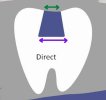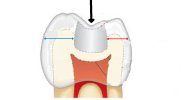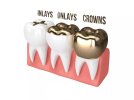I have two fillings that fell out on my back two teeth next to my wisdom teeth. I circled them in the photo. They are pretty small and I am not sure what to do. I want to get a gold inlay or filling but the dentist I trust does not do that. Should I just get the white fillings done or an inlay and what kind? I also circled a small brown spot that is a cavity that I need to fix. Its the first cavity I've ever had in my life. My other fillings were done by a bad dentist who gave me unnecessary work. But the two I am talking about are small and they actually look like a normal tooth except when I look under sunlight I can see the two lines. What should I do. I wish I trusted the white filling material but it doesnt last long. What is your opinion? It does get tiresome because my tongue is constantly traveling there. Should I just leave them? The reason I trust my dentist is because he uses a microblaster and that will preserve my teeth better. Also can I chew gum when I get them fixed?
Im really sad because I trusted a bad dentist and did all the things your not supposed to do. Wish I had gone to a good dentist from the beginning

Im really sad because I trusted a bad dentist and did all the things your not supposed to do. Wish I had gone to a good dentist from the beginning




